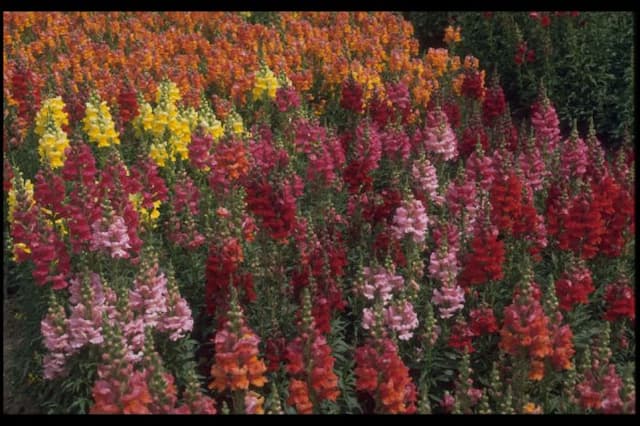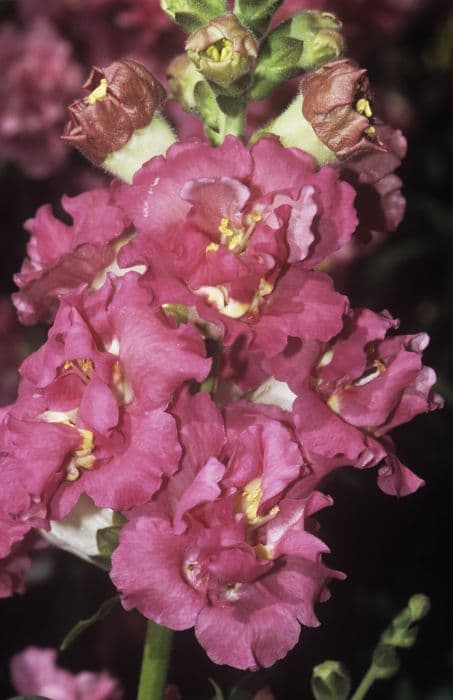Beardtongue Penstemon 'Countess of Dalkeith'

ABOUT
Penstemon 'Countess of Dalkeith', commonly known as beardtongue, is a perennial plant cherished for its ornamental appeal. Its foliage typically consists of lance-shaped leaves that are arranged neatly along the stems. The leaves are often deep green, providing a lush background for the striking blooms that make beardtongue a garden favorite. The flowers of the 'Countess of Dalkeith' variety are particularly eye-catching, forming tubular structures that come in a vivid shade. Each tubular bloom is flanked by smaller petals, creating a contrasting appearance. These blooms are arrayed along the stem in panicles or clusters, giving the plant a profuse, colorful display when in bloom. Beardtongue's flowers are known to attract pollinators such as hummingbirds and bees, adding to the dynamism of any garden space. The plant itself is typically sturdy, with upright stems that hold the blooms aloft, providing visual interest throughout its blooming season. Overall, the Penstemon 'Countess of Dalkeith' presents a captivating sight with its combination of vibrant flowers and verdant foliage, making it a favored choice among gardeners seeking to add a splash of color to their landscape.
About this plant
 Names
NamesFamily
Plantaginaceae
Synonyms
Beardtongue
Common names
Penstemon 'Countess of Dalkeith'.
 Toxicity
ToxicityTo humans
The Beardtongue is generally considered non-toxic to humans. There are no well-documented cases of poisoning from ingesting this plant. However, as with any plant not intended for consumption, it's always possible that some individuals may experience mild gastrointestinal discomfort or an allergic reaction if they ingest parts of the plant.
To pets
The Beardtongue is also not known to be toxic to pets. It is not listed as a poisonous plant for pets such as dogs and cats. As with humans, ingestion may potentially lead to mild stomach upset, but there are no significant toxic effects expected from this plant for pets.
 Characteristics
CharacteristicsLife cycle
Perennials
Foliage type
Deciduous
Color of leaves
Green
Flower color
Pink
Height
2-3 feet (60-91 cm)
Spread
1-2 feet (30-60 cm)
Plant type
Herb
Hardiness zones
4-9
Native area
North America
Benefits
 General Benefits
General Benefits- Attracts pollinators: Penstemon, commonly known as Beardtongue, is known to attract bees, butterflies, and hummingbirds, supporting local ecosystems.
- Drought-tolerant: Once established, it requires minimal watering, making it an excellent choice for water-wise gardens.
- Low maintenance: Beardtongue is generally an easy-to-care-for plant that does not require frequent fertilization or pruning.
- Ornamental value: With its tubular flowers and attractive foliage, Penstemon adds visual interest to borders, beds, and ornamental gardens.
- Versatile planting: This plant is suitable for a variety of garden styles including rock gardens, cottage gardens, and wildflower meadows.
- Long blooming period: Beardtongue flowers from late spring to early summer, providing a long season of visual enjoyment.
- Deer resistant: Penstemon is not a preferred choice for deer, making it a good option for gardens in areas with deer populations.
 Medical Properties
Medical PropertiesThis plant is not used for medical purposes.
 Air-purifying Qualities
Air-purifying QualitiesThis plant is not specifically known for air purifying qualities.
 Other Uses
Other Uses- Hummingbird attractant: The tubular flowers of the Penstemon are particularly appealing to hummingbirds, providing a nectar source which in turn helps in pollination.
- Butterfly garden plant: Penstemon can be used in butterfly gardens to attract and feed butterflies with their nectar-rich blooms.
- Erosion control: Their root systems can help stabilize soil in sloped gardens or areas prone to erosion.
- Dye production: Some species of Penstemon can be used to create natural dyes for textiles, though it's uncommon and not well-documented for 'Countess of Dalkeith'.
- Photography subject: The vibrant and detailed structure of Penstemon flowers makes them great subjects for botanical photography.
- Artistic inspiration: Artists may use these plants as a model for botanical drawing, painting, or other forms of art.
- Educational tool: Penstemon can be used in educational settings to demonstrate plant biology, pollination, and horticultural practices.
- Marker plants: They can be used to delineate spaces within a garden or as visual markers for garden design due to their distinct growth habit and color.
- Culinary garnish: Although not commonly consumed, the flowers of some Penstemon varieties could be used as edible garnishes in high-end culinary presentations, provided they are free of pesticides and other chemicals.
- Landscape design: With their striking colors and varying heights, Penstemon can be important in designing visually appealing landscapes.
Interesting Facts
 Feng Shui
Feng ShuiThe Beardtongue is not used in Feng Shui practice.
 Zodiac Sign Compitability
Zodiac Sign CompitabilityThe Beardtongue is not used in astrology practice.
 Plant Symbolism
Plant Symbolism- Beauty and Grace: The Penstemon 'Countess of Dalkeith', known commonly as Beardtongue, is often associated with beauty and grace due to its elegant flowers and stately form.
- Health and Vitality: Beardtongues are known for their hardiness and ability to thrive in diverse environments, symbolizing robust health and vitality.
- Communication and Openness: The common name 'Beardtongue' is a nod to the open mouth-like appearance of the flower, which can symbolize openness in communication.
 Water
WaterBeardtongue should be watered deeply once a week during its active growing season, which typically occurs in spring and summer. Aim for the equivalent of one inch of rainfall, which translates to approximately 0.6 gallons for a medium-sized plant. During periods of drought or extreme heat, increase watering frequency to twice a week. It’s important to allow the soil to dry out slightly between waterings to prevent root rot. In the winter, reduce watering significantly and only provide water if the soil is completely dry to the touch.
 Light
LightBeardtongue thrives in spots that receive full sun to partial shade. Ideally, it should get at least six to eight hours of direct sunlight each day. Places that offer morning sunlight and some afternoon shade are perfect, particularly in regions with very hot summers.
 Temperature
TemperatureBeardtongue plants prefer moderate temperatures and can do well in climates where the temperature ranges from approximately 40°F to 85°F. They're hardy to USDA Zone 3, which can reach minimum temperatures of -40°F. These plants can tolerate brief periods of colder temperatures down to about -30°F, but prefer to be within the moderate range during their growing season.
 Pruning
PruningBeardtongue should be pruned to encourage bushiness and to maintain a neat appearance. Deadheading, or the removal of spent flowers, will promote continued blooming throughout the season. After the first killing frost, cut back the stems to about an inch above the soil level. This also helps to prevent disease and prepares the plant for winter.
 Cleaning
CleaningAs needed
 Soil
SoilBeardtongue thrives in well-draining, loamy soil with a slightly acidic to neutral pH between 6.0 to 7.0. A mix of garden soil, compost, and sharp sand or perlite will create an optimal environment for Penstemon 'Countess of Dalkeith'.
 Repotting
RepottingBeardtongue does not require frequent repotting and can be done every 2-3 years or when the plant has outgrown its current container. The best time to repot is in the spring.
 Humidity & Misting
Humidity & MistingBeardtongue prefers moderate humidity levels but is quite adaptable and can tolerate the lower humidity found in many home environments. Avoid extremely high humidity to prevent disease.
 Suitable locations
Suitable locationsIndoor
Ensure bright light, well-draining soil, and avoid overwatering.
Outdoor
Full sun to partial shade, well-drained soil, protect from extreme cold.
Hardiness zone
4-9 USDA
 Life cycle
Life cycleThe Penstemon 'Countess of Dalkeith', commonly referred to as Beardtongue, begins its life cycle with seed germination, which is highly dependent on temperature and soil conditions. Upon germination, the seedling develops a root system and foliage, emerging as a small plant. As the Beardtongue matures, it produces a rosette of leaves at ground level in its first year, with stem growth and leaf production continuing as it enters its vegetative stage. Floral development occurs afterwards, with the plant producing tall spikes adorned with tubular flowers that attract pollinators such as bees and hummingbirds. Following pollination, the flowers develop into fruit containing seeds, which are then dispersed to give rise to new plants. The plant may enter a period of dormancy during colder months, only to resume growth and flowering in the following season, thereby continuing its perennial life cycle.
 Propogation
PropogationPropogation time
Spring to Early Summer
The most popular method of propagation for the Penstemon 'Countess of Dalkeith', often referred to as Beardtongue, is through stem cuttings. This is ideally done in late spring to early summer when the plant is actively growing. Select a healthy, non-flowering stem and cut a segment approximately 4 to 6 inches (about 10 to 15 centimeters) long just below a node, which is where leaves and buds are attached to the stem. Remove the lower leaves and dip the cut end into rooting hormone to encourage root development. Then, plant the cutting in a well-draining soil mix, water it thoroughly, and place it in a location with indirect light. Keep the soil consistently moist but not waterlogged. Roots typically develop within a few weeks, after which the cutting can be transplanted into a larger pot or directly into the garden.





![Snapdragon [Pretty in Pink]](/_next/image?url=https%3A%2F%2Fplants-admin.emdemapps.com%2Fimages%2Fplants%2F%2Fimages%2F604b5cb3b5385.png&w=640&q=75)



